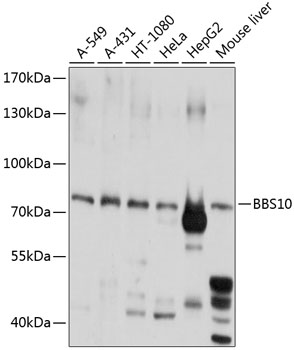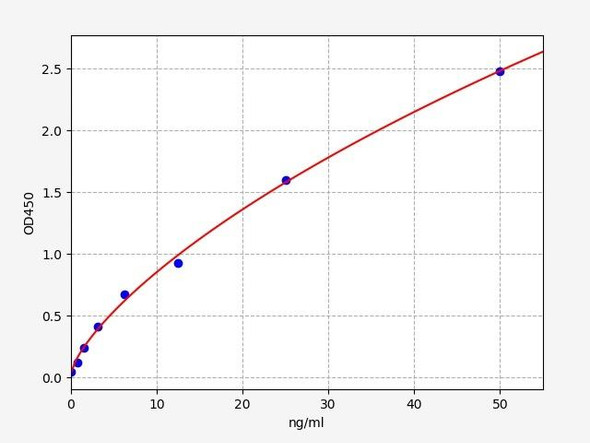Signal Transduction Antibodies 3
Anti-BBS10 Antibody (CAB8820)
- SKU:
- CAB8820
- Product Type:
- Antibody
- Applications:
- WB
- Reactivity:
- Human
- Reactivity:
- Mouse
- Host Species:
- Rabbit
- Isotype:
- IgG
- Research Area:
- Signal Transduction
Description
| Antibody Name: | Anti-BBS10 Antibody |
| Antibody SKU: | CAB8820 |
| Antibody Size: | 20uL, 50uL, 100uL |
| Application: | WB |
| Reactivity: | Human, Mouse |
| Host Species: | Rabbit |
| Immunogen: | Recombinant fusion protein containing a sequence corresponding to amino acids 474-723 of human BBS10 (NP_078961.3). |
| Application: | WB |
| Recommended Dilution: | WB 1:200 - 1:3000 |
| Reactivity: | Human, Mouse |
| Positive Samples: | A-549, A-431, HT-1080, HeLa, HepG2, Mouse liver |
| Immunogen: | Recombinant fusion protein containing a sequence corresponding to amino acids 474-723 of human BBS10 (NP_078961.3). |
| Purification Method: | Affinity purification |
| Storage Buffer: | Store at -20'C. Avoid freeze / thaw cycles. Buffer: PBS with 0.02% sodium azide, 50% glycerol, pH7.3. |
| Isotype: | IgG |
| Sequence: | AENK DALE KTQT YLKV HSNL VIPD VELE TYIP YSTP TLTP TDTF QTVE TLTC LSLE RNRL TDYY EPLL KNNS TAYS TRGN RIEI SYEN LQVT NITR KGSM LPVS CKLP NMGT SQSY LSSS MPAG CVLP VGGN FEIL LHYY LLNY AKKC HQSE ETMV SMII ANAL LGIP KVLY KSKT GKYS FPHT YIRA VHAL QTNQ PLVS SQTG LESV MGKY QLLT SVLQ CLTK ILTI DMVI TVKR HPQK VHNQ DSED EL |
| Gene ID: | 79738 |
| Uniprot: | Q8TAM1 |
| Cellular Location: | Cell projection, cilium |
| Calculated MW: | 80kDa |
| Observed MW: | 80kDa |
| Synonyms: | BBS10, C12orf58 |
| Background: | This gene is a member of the Bardet-Biedl syndrome (BBS) gene family. Bardet-Biedl syndrome is an autosomal recessive disorder characterized by progressive retinal degeneration, obesity, polydactyly, renal malformation and mental retardation. The proteins encoded by BBS gene family members are structurally diverse and the similar phenotypes exhibited by mutations in BBS gene family members is likely due to their shared roles in cilia formation and function. Many BBS proteins localize to the basal bodies, ciliary axonemes, and pericentriolar regions of cells. BBS proteins may also be involved in intracellular trafficking via microtubule-related transport. The protein encoded by this gene is likely not a ciliary protein but rather has distant sequence homology to type II chaperonins. As a molecular chaperone, this protein may affect the folding or stability of other ciliary or basal body proteins. Inhibition of this protein's expression impairs ciliogenesis in preadipocytes. Mutations in this gene cause Bardet-Biedl syndrome type 10. |
| UniProt Protein Function: | BBS10: Probable molecular chaperone. Assists the folding of proteins upon ATP hydrolysis. As part of the BBS/CCT complex may play a role in the assembly of BBSome, a complex involved in ciliogenesis regulating transports vesicles to the cilia. Involved in adipogenic differentiation. Defects in BBS10 are the cause of Bardet-Biedl syndrome type 10 (BBS10). Bardet-Biedl syndrome (BBS) is a genetically heterogeneous, autosomal recessive disorder characterized by usually severe pigmentary retinopathy, early onset obesity, polydactyly, hypogenitalism, renal malformation and mental retardation. Belongs to the TCP-1 chaperonin family. |
| UniProt Protein Details: | Chromosomal Location of Human Ortholog: 12q21.2 Molecular Function:protein binding Biological Process: chaperone-mediated protein complex assembly; photoreceptor cell maintenance; regulation of protein complex assembly; retinal homeostasis; sensory cilium biogenesis Disease: Bardet-biedl Syndrome 10 |
| NCBI Summary: | This gene is a member of the Bardet-Biedl syndrome (BBS) gene family. Bardet-Biedl syndrome is an autosomal recessive disorder characterized by progressive retinal degeneration, obesity, polydactyly, renal malformation and mental retardation. The proteins encoded by BBS gene family members are structurally diverse and the similar phenotypes exhibited by mutations in BBS gene family members is likely due to their shared roles in cilia formation and function. Many BBS proteins localize to the basal bodies, ciliary axonemes, and pericentriolar regions of cells. BBS proteins may also be involved in intracellular trafficking via microtubule-related transport. The protein encoded by this gene is likely not a ciliary protein but rather has distant sequence homology to type II chaperonins. As a molecular chaperone, this protein may affect the folding or stability of other ciliary or basal body proteins. Inhibition of this protein's expression impairs ciliogenesis in preadipocytes. Mutations in this gene cause Bardet-Biedl syndrome type 10. [provided by RefSeq, Jan 2010] |
| UniProt Code: | Q8TAM1 |
| NCBI GenInfo Identifier: | 97043964 |
| NCBI Gene ID: | 79738 |
| NCBI Accession: | Q8TAM1.2 |
| UniProt Secondary Accession: | Q8TAM1,Q96CW2, Q9H5D2, |
| UniProt Related Accession: | Q8TAM1 |
| Molecular Weight: | 80,838 Da |
| NCBI Full Name: | Bardet-Biedl syndrome 10 protein |
| NCBI Synonym Full Names: | Bardet-Biedl syndrome 10 |
| NCBI Official Symbol: | BBS10 |
| NCBI Official Synonym Symbols: | C12orf58 |
| NCBI Protein Information: | Bardet-Biedl syndrome 10 protein |
| UniProt Protein Name: | Bardet-Biedl syndrome 10 protein |
| Protein Family: | Bardet-Biedl syndrome 10 protein |
| UniProt Gene Name: | BBS10 |
| UniProt Entry Name: | BBS10_HUMAN |
View AllClose







